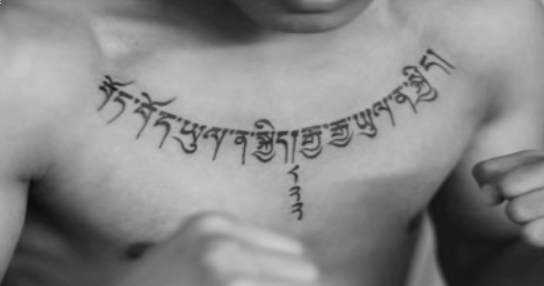Censored belly, Tibetan tattoo
« previous post | next post »
[This is a guest post by Jichang Lulu.]
Imagine that a certain phrase could be potentially offensive to the authoritarian rulers of a country you would like to do business in. To promote that business, you intend to display images of certain professionals who work for you. One of these professionals has indelibly inscribed the potentially offensive phrase on their belly. The professional activity you wish to promote typically involves barebelliedness.

Such was the conundrum faced by Dana White, president of the UFC (Ultimate Fighting Championship), a mixed martial arts (MMA) organisation. The profession was MMA fighter. The country was China. The phrase was in the Tibetan script. The belly belonged to British fighter Dan Hardy.

White's way out of the conundrum:

[UFC 111 poster via middleasy]
Photoshop surgery, reportedly involving a transplant from a picture of another fighter.
White's explanation:
“This thing popped up and I heard that it was anti-Chinese government, so I ripped that thing off it. I’m not going to put him on a poster with anti-Chinese government writing on it when we’re trying to get into China…. I don’t [know] what this stuff means, so I’ve got to be safe.”
By censoring Hardy's belly text (腹文), White was being more Catholic than the Pope. There's nothing 'anti-Chinese government' or political about the text, which is simply the Sanskrit mantra oṃ maṇi padme hūṃ in Tibetan script. Hardy seems quite familiar with its pronunciation and religious significance and an interpretation of its meaning, and there's no suggestion of a political motive.
The mantra isn't forbidden in China, in its Tibetan or Chinese form, pronounced 唵嘛呢叭咪吽 ǎn má ní bā mī hōng (among other variants).
As if that didn't make it obvious enough that the mantra isn't off-limits in China, two weeks before the fight, while UFC were busy airbrushing the tattoo off of Hardy's stomach, popular Mainland website Sohu 搜狐 published an article with multiple pictures of him, mantra and all.

This is old news (indeed seven years old), although I was only alerted to it today by this post's host. It is quite topical though, a week after a similar incident. This time, the China-savvy business is Cambridge University Press; the inscribed surface is China Quarterly; the censored text is that of hundreds of articles deemed too politically sensitive to be made available in China. CUP willingly "complied" with an "instruction from a Chinese import agency" and blocked access to the articles from China, "to ensure that other academic and educational materials" could still be marketed there. CUP's best-selling item in China is an English-language course book.
CUP did promise to raise the matter with the "relevant agencies" (Oxbridge for 'the Relevant Departments' (有关部门 yǒuguān bùmén)) at the Beijing Book Fair, an event that made news when Western publishers in attendance openly discussed how they self-censor to stay in China. CUP eventually volte-faced, but the long-term trend clearly favours censorship and frequent CUPping. Some academics aren't going to generate more profit than English materials with a heraldicky logo on them. As I argued in a recent blog post, authors who can't trust CUP not to draw-and-quarter China Quarterly next time it displeases some authoritarian regime might want to consider doing to CUP what Lingua did to Elsevier.
A Sanskrit tattoo has been discussed on Language Log before, namely the one on Hong Kong politician Yau Wai-ching 游蕙祯. Yau continued to make language-related news thanks to her peculiar word choice in Cantonese and English. Hong Kong's legislature, only some of whose members are elected by the population at large, later kicked her out.
For an explicitly political Tibetan MMA tattoo, you need to look at Wangden Namshi དབང་ལྡན་རྣམ་ཞི།.

Wangden Namshi via Tibet Express
He trains (or used to) at the bilingually-named Kampfsportcenter St. Gallen. Here's Wangden fighting, and here's a video (in Tibetan and English) with him getting tattooed.
Wangden's tattoo reads:
བོད་བོད་ཡུལ་ན་སྐྱིད། རྒྱ་རྒྱ་ཡུལ་ན་སྐྱིད།
bod bod yul na skyid / rgya rgya yul na skyid
'The Tibetans [will be] happy in Tibet; the Chinese [will be] happy in China.'
This is a quotation from the 9th-century Sino-Tibetan treaty stele 唐蕃会盟碑 Táng-Fān huì méng bēi (still standing outside the Jokhang in Lhasa). Many Tibetans cite it as proof that Tibet and the Tang interacted as independent polities. Official PRC materials also often mention the inscription, although they put a different spin on it.
Here's the relevant Chinese text on the stele:
蕃於蕃國受安漢亦漢國受樂
Fān yú Fān guó shòu ān, Hàn yì Hàn guó shòu lè.
Here the Chinese (Hàn) get happiness in the Han country, while the Tibetans (Fān) get just 'peace' in the Fan country.

languagehat said,
August 29, 2017 @ 7:21 am
བོད་བོད་ཡུལ་ན་སྐྱིད། རྒྱ་རྒྱ་ཡུལ་ན་སྐྱིད།
bod bod yul na skyid / rgya rgya yul na skyid
'The Tibetans [will be] happy in Tibet; the Chinese [will be] happy in China.'
I don't understand how yul na skyid can mean both 'happy in Tibet' and 'happy in China' (as far as I can tell, the Tibetan script is identical in both, so it's not a matter of homophones).
Victor Mair said,
August 29, 2017 @ 7:35 am
bod = Tibet
rgya = China
yul = country
languagehat said,
August 29, 2017 @ 8:34 am
Oh, of course, bod yul na skyid 'happy in Tibet' and rgya yul na skyid 'happy in China.' Sorry, that should have been obvious!
Jichang Lulu said,
August 29, 2017 @ 8:52 am
@languagehat
bod bod yul na skyid | rgya rgya yul na skyid
Tibet(an) Tibet(an)-land-LOC happy | China/Chinese China-land-LOC happy
Jichang Lulu said,
August 29, 2017 @ 9:23 am
"a matter of homophones"
The romanisation I gave for the stele quote (Wylie) transliterates the Tibetan script, so it distinguishes exactly the same homophones as the original. Here's a broad transcription of what it can sound like in one of the possible Lhasa pronunciations (segments in IPA; acutes/graves: start from high/low tone)
`phø: `phy:y:nə ´ci `ca `cay:nə ´ci
It can also be pronounced without the aspirations; the palatals c- can be kj-; the -a in na may not be reduced. Other varieties of Tibetan would give (very) different pronunciations. Back in the 9th century, the pronunciation would have been significantly closer to the written form.
You can listen to the phrase in Tibetan in a video linked from the post. Here's a direct link to where it starts: 0:55.
languagehat said,
August 29, 2017 @ 9:34 am
Here's a broad transcription of what it can sound like
Thanks, that's very useful!
Terrence G. said,
August 29, 2017 @ 4:22 pm
What is the etymology of the word 'rgya' for "China". Is there a character for this? Is it related to 夏 ɡraːʔ or even 羌 kʰlaŋ What is the reconstructed pronunciation of 'rgya'?
Victor Mair said,
August 29, 2017 @ 5:21 pm
@Terrence G.:
Please read VHM, "Was There a Xià Dynasty?", free pdf available at Sino-Platonic Papers, 238: http://www.sino-platonic.org/
Jichang Lulu said,
August 29, 2017 @ 5:56 pm
Glad the rgya-夏 issue has come up. I was about to mention it.
Here's a direct link to Victor Mair's paper. Discussion of rgya starts on page 11. Mair gives reconstructions in the Li Fang-kuei tradition; Terrence G. above gives what Iooks like Zhangzheng Shangfang's reconstruction. Baxter and Sagart have no distinctive length, but a pharyngealised initial instead for this type of syllable (called 'type A'). They could reconstruct a voiced velar or uvular.
Matt said,
August 30, 2017 @ 3:06 am
Was a bit disappointed to learn that "腹文" is not apparently a word in common usage, but searching ctext.org I did find this description of a phoenix (鳳皇) in the Classic of Mountains and Seas:
In Journal of the Asiatic Society translation:
Best imagined facing off in the ring against a qilin tattooed with Non-action and Perfected man and so on.
F Robin said,
August 30, 2017 @ 3:21 am
C. Beckwith has published in Journal Asiatique 2016 an article about Rgya, as derived from, according to him, the earliest Chinese word for "Chinese", i.e. Hia, archaic pronounciation Harya, which he links to Arya (hence Tibetan Rgya)
http://poj.peeters-leuven.be/content.php?url=article&id=3186091
Terrence G. said,
August 30, 2017 @ 10:39 am
@VHM @Jichang Lulu @F Robin Thank you for the references. I read the article by @VHM It is very informative. I'll read the article by Beckwith later.
I guess there is no real conclusion yet regarding the connection between rgya and ɡraːʔ (yes it is Zhengzhang's reconstruction). It seems to me though the arguments are mostly made using evidence in Chinese, and very little evidence is given regarding the ancient history of Tibet.
Written Tibetan only goes back to early Middle Chinese, but we are talking about early Old Chinese and Proto-Chinese (or Proto-Sinitic). I wonder if there is any article that discusses the prehistory of the language(s) and people(s) in Tibet so that we can make a more chronologically correct comparison.
Eidolon said,
August 30, 2017 @ 7:25 pm
"C. Beckwith has published in Journal Asiatique 2016 an article about Rgya, as derived from, according to him, the earliest Chinese word for "Chinese", i.e. Hia, archaic pronounciation Harya, which he links to Arya (hence Tibetan Rgya) http://poj.peeters-leuven.be/content.php?url=article&id=3186091"
I have heard about Beckwith's reconstruction of Xia/Hua as "Harya" as early as 2014, so its origin must have been earlier than 2016, though it must post-date 2009, because I found no mention of it in "Empires of the Silk Road." But I cannot seem to find the original reference. Regardless, has anyone accepted his reconstruction in the linguistics community? It seems a rather important idea, in light of the fact that Chinese historians still believe in the existence of a very ancient Xia dynasty, tribe, or geographical location. Beckwith can be controversial, to say the minimum, so I'd love to know what other linguists think.
Victor Mair said,
August 31, 2017 @ 5:44 am
From Matthew Kapstein:
rgya does not mean 'country'. It means an 'expanse,' 'extended area' and is related to the verb rgyas, 'to expand.'
Tang period Tibetan transcribes xia as ga, which I have discussed in connection with the Tibetan transcription of Daxia as De-ga.
Traditionally, the Tibetan explanation of rgya-nag for China is 'the area (rgya) where people are clothed in black (nag),' though this looks like folk etymology.
Victor Mair said,
August 31, 2017 @ 5:50 am
From Leonard van der Kuijp:
It is interesting that the Tibetan has "happiness" (skyid) in both places. The Chinese text, however, is different and of course the translation is not accurate.
蕃於蕃國受安漢亦漢國受樂
Fān yú Fān guó shòu ān, Hàn yì Hàn guó shòu lè.
Here the Chinese (Hàn) get happiness in the Han country, while the Tibetans (Fān) get just 'peace' in the Fan country.
"The Tibetans get peace in Tibet country; the Han get happiness in Han country."
There is an interesting note on the term rgya gar in Bu ston Rin chen grub's (1290-1364) discussion of the title of the Pramāṇaviniścaya where he speaks of the meaning/origin of gar in rgya gar ("India"), but is silent on the meaning/origin of rgya. Maybe he felt it was obvious, maybe he did not know it himself. Even the meaning/origin of gar was a problem for him! And, if it was a problem for him, then it is certainly one for me!!
Victor Mair said,
August 31, 2017 @ 5:53 am
From Randy J. LaPolla:
As you mentioned in your paper, the word rGya was used for both India and China. My view would be that the use for India probably preceded the use of the word for China, as the relevant contact with India was earlier and more intense than with China, and the word for China has an obvious disambiguator added to it (China was called rGya nag ‘black rGya’). At the time of the relevant contact (Tang period) the Chinese didn’t call themselves Xia, and even if they did by that time the word would not look like the Old Chinese reconstructions. So my view is that the Tibetans had a word for the Indians (and it may have even come from an Indian language), and later they applied the same word to the Chinese. Compare this with the use of 番 by the Chinese for all sorts of foreigners (which, by the way, I think came from the use of the word for ‘fence’ (番=藩), as in the feudal period the 藩國 formed a protective fence/screen around the central kingdom, and I think this got extended to any outlying kingdoms—there is nothing in the history of the word to mean ‘barbarian’, as it is often translated in English).
Victor Mair said,
August 31, 2017 @ 9:45 am
From a Tibetologist:
Most Tibetologists will tell you rgya is a native word that means 'big'. You get it in rgya-mtsho 'big lake' (= ocean). I also associate the idea that it transliterates a Chinese word with Chris Beckwith.
I am skeptical of his proposal of *Harya, but *rya is certainly a possible reconstructed ancestor of rgya, following what i call Li's law (ry > rgy) which is most obvious in the words for 'eight' and 'hundred'. Li published it in the Studia Karlgren dedicata, but Matisoff seems never to have noticed.
Terrence G. said,
August 31, 2017 @ 10:25 am
I find Randy J. LaPolla's and Nathan Hill's explanations very interesting. According to LaPolla's view cited above, the word "rGya" is probably not related to the name 夏, although it could be a cognate word with the meaning "big".
Also regarding Li's law, I find the sound change ry>rgy interesting, and wonder if there is any phonological/phonetic explanation for this?
On the other hand, I am not quite sure about the metathesis in rgya~ɡraːʔ, although it is a common sound change pattern.
Victor Mair said,
August 31, 2017 @ 10:26 am
From a Chinese historical linguist:
rGyarong 嘉戎, Lavrong 拉坞戎, a recently discovered TB language in Szechuan, contains the ethnic name Rong 戎。 Graham Thurgood and Randy La Polla in The Sino-Tibetan Languages set up a Rong subgroup. You can also read Pulleyblank “Chinese and her neighbors” and P also spoke of Rong. The ethnic 羌 Qiang is a standard designation in TB linguistics. I believe 犬戎 is the earliest Rong known to the Chinese.
I think the Rong theory proposed by Pulleyblank and Thurgood and La Polla makes a great deal of sense. After the splitting up of ST, the Tibeto-Burmans were west of the Sinitic. China’s TB foes, Tibetans during the Tang and the Tangut of the Song, were in the west. Their earlier ancestors, known in Chinese texts as the Qiang 羌, and the Rong 戎 are west of the Chinese, e.g. 西戎。
Terrence G. said,
August 31, 2017 @ 10:35 am
Also regarding LaPolla's comment, I think he is right that if the cultural contact occurred only in Tang (or possibly earlier in Sui), it is also evidence against the connection between rGya and 夏, because the Chinese people did not commonly refer to themselves as 夏 during the Tang dynasty. Maybe the Tibetans just referred to the Tang as the "Big Country" ("rGya").
Terrence G. said,
August 31, 2017 @ 10:39 am
In @VHM's paper, Nathan Hill is quoted as saying there might be a connection between rGya and rGyal in the word "rGyalrong". I wonder if anyone has elaborated on that connection.
Victor Mair said,
August 31, 2017 @ 2:24 pm
rGyalrong is 嘉戎,Lavrung is 拉坞戎。Here is some some bibliographic information。In The SINO-TIBETAN LANGUAGES, the first chapter “Sino-Tibetan Subgroupings” is written by Graham Thurgood, and on p. 14, 4.5 The Rung branch. “By Rung is meant LaPolla’s large group consisting of the rGyalrong languages, the Dulong languages (T’rung, Rawang), the Kiranti langiages, the West Himalayan langiages (Kiranti, Almora), ham, and less probably, Magar, and Chepang.”
There is a Chinese translation of Graham Thurgood’s 杜冠明 article:汉藏语系:谱系传承, 文化接触以及历史文化。 To find that article, type in Chinese on Google:汉藏语的起源。 That will get you to 汉藏语的起源;优秀论文范文十篇。 Thurgood’s article is 范文5 (model article no. 5). Sure enough, “the Rung branch” is translated 戎语支。
languagehat said,
August 31, 2017 @ 3:18 pm
Guillaume Jacques says:
There is further discussion of Gyalrongic at this LH post.
Victor Mair said,
August 31, 2017 @ 9:45 pm
From Matthew Kapstein:
Quick check of Old Tibetan materials suggests that in fact rgya alone was used for China before the compound rgya nag was current. This does imply to me that rgya may have been an old loan word — but from what? — and just a homonym of Tibetan rgya 'expanse, area.' In that case it would have been natural, over time, for Tibetans to have interpreted it in terms of their own lexeme. I don't have my Chinese references with me, but what would have been the pronunciation of hua in old or middle Chinese? Otherwise, I suppose it's also possible that rgya is indeed the Tibetan 'expanse,' but as a translation of xia in the sense of 'grandeur,' not a transcription. And because middle Ch. xia was phonetically taken by Tibetans as ga, perhaps it was phonetically just slightly suggestive of rgya, allowing a sort of meaning-sound pun.
Victor Mair said,
August 31, 2017 @ 11:22 pm
@Matthew Kapstein:
huá 華
Middle Sinitic:
Zhengzhang Shangfang /ɦˠua/
Pan Wuyun /ɦʷᵚa/
Shao Rongfen /ɣua/
Edwin Pulleyblank /ɦwaɨ/
Li Rong /ɣua/
Wang Li /ɣwa/
Bernard Karlgren /ɣwa/
Old Sinitic
Baxter-Sagart: /*N-qʷʰˤra/
Zhengzhang: /*ɡʷraː/
Victor Mair said,
September 1, 2017 @ 6:57 am
From James Matisoff:
Randy's comment seems very apposite to me. At a much more recent time-depth, there is an analogical case in Lahu. The Lahu word for India is kala, which is a borrowing from Burmese "Kula", possibly from the Chola dynasty of southern India (ca. 300 BC to 1279 AD). This Lahu word has recently been extended to non-Asian foreigners, so that Caucasians are now called "kala-phu" or "white kala", so that Indians are now called "kala-na" or "black kala". (Afro-Americans are called "Kalaphu na" or "white black Indians".)
BTW I don't think Tib. rgya comes from Chola, which was too far south.
Jichang Lulu said,
September 4, 2017 @ 3:53 pm
Thanks to everyone for these comments.
In addition to the papers by Mair and Beckwith that have been quoted, I'd like to mention this one by Wolfgang Behr, which discusses six possible etymologies for Chinese xià 夏 as a demonym. Two of those six he finds most attractive based on early attested materials: a derivation from 贾 gǔ, and a meaning 'motley, blooming' possibly related to Tibetan bkra and khra and Burmese ka: and kjahi, although the medial in the latter Burmese form is problematic. (This is discussed on pages 13 and 14 of the pdf linked above.)
Chris Button said,
September 5, 2017 @ 2:31 pm
Burmese "kjah" should really be glossed as "striped" and is surely a derivation from its nominal meaning of "tiger". The Burmese inscriptions attest the word for "tiger" with medial "l" (the l > j after k) from which its origins as a Mon-Khmer loanword are apparent (the Chinese relationship is with 虎). On the basis of the above, I think any connection with rGya or 夏 can be safely ruled out.
Chris Button said,
September 6, 2017 @ 12:54 pm
@ A Sino-Tibetanist
Regarding the origin of Burmese "ku.la:" (Indian), I think the more standard association is with Pali/Sanskrit "kula" (caste/family) as proposed by Gordon Luce in 1959 (JBRS 42.1).
Victor Mair said,
September 8, 2017 @ 2:15 pm
From Julian Wheatley:
I can't think of any reliable Burmese data. I'm assuming that Tib.rgya is in fact cognate to 夏 (Baxter's
*[G]ʕraʔ) rather than a loan (since as noted in the log, Xia wasn't current as a name for China in the Tang), and that the relevant Bs word would mean something like "expanse" or perhaps "extent, area". No reason for it to also be applied to China – "the great country", although that would help narrow down the possibilities.
There is a word: (Mod. Bs.) kyay 'wide, broad, spacious', which Matisoff (Handbook) has cognate with an obscure Chinese cognate (written with 侈 inside 广 - perhaps a graphic variant of 侈 'extravagant'). But by Li's Law, the velar initial is epenthetic, so I should be looking for something more like ya (cp. Tib. brgya '100', Bs. ya). Nothing comes to mind, but I'm primed should something show up.
Chris Button said,
September 8, 2017 @ 8:03 pm
This is a speculative suggestion, but I thought I would offer it up for comment nonetheless…
Although 夏 is reconstructed as something like OC *gráʔ on the basis of its rhyming, it might perhaps be of significance (particularly given a possible convergence of two unrelated words) that a form like *grájʔ would produce the same Middle Chinese reflex. The ablaut form of *grájʔ is *grә́jʔ (via the ə/a alternation) which happens to be a perfect correlate for Burmese kri: "big" even down to the tone.
Jichang Lulu said,
September 9, 2017 @ 5:27 am
Thanks for these further comments on Burmese.
Among those who have entertained the possibility of rgya being a Chinese loan, I don't think anyone has suggested Tibetan directly borrowed 夏 from Middle Chinese. The idea is rather that an ancestor of Tibetan might have borrowed the word (in the sense 'Chinese') from Old Chinese. That's what Beckwith is saying. His argument depends on (a) rgya being the result of a metathesis and (b) his own Chinese reconstruction.
As for cognates of Tibetan rgya 'expanse', whatever the connection to 'China', Zhangzhung lgyam has been compared to Tibetan rgyas 'wide; increase' (related to rgya) in Dan Martin's Zhangzhung dictionary. Martin calls the entry 'dubious', since it's solely based on its occurrence in the Abhidharma term pra lgyam ~ Tib. phra rgyas 'predisposition, propensity' (Skt. anuśaya). This paper by Guillaume Jacques proposes Qiangic cognates for the 'wide' interpretation (which in turn leads to further Sino-Tibetan comparanda), but also argues that 'increase' could be a valid reading.
Nathan Hill said,
September 9, 2017 @ 7:48 am
On the phonetic motivation for Li's law see–
Hall, T. A. and Silke Hamann (2010). ‘On the cross-linguistic avoidance of rhotic plus high front vocoid sequences.’ Lingua 120: 1821–1844.
As far as I know Randy LaPolla himself is the only person who believes his Rong proposal. If you want to see some nice bickering, consult the dozen or so articles back and forth between him and DeLancey. I am personally inclined toward DeLancey's side, but the question is moot until more is known about the historical phonology of a good number of languages.
Victor Mair said,
September 9, 2017 @ 6:21 pm
From a Chinese historical linguist:
蕃於蕃国受安 is subtle. 安 as a verb means ‘to pacify’. 受安 can mean ‘receive peace’ or it can also shade to ‘receive pacification, being pacified’. The Treaty really says the Chinese gave up an indefensible outpost and moved the border into the path in the mountain (which is more easily defended). But the Chinese would like to claim victory — hence the play of words in the Chinese version.
Another way the Chinese exercise censorship is simply to refuse to republish. The Chinese translation of Jerry Norman’s Chinese had the full support of Zhu Dexi. When he was alive he required all his graduate students to read Norman’s Chinese. But this book offended the authorities. For what reason I do not know; maybe because it advocated that the area south of the Yangtze was occupied by the Mon-Khmers, the ancestors of the Vietnamese. In any case it was out of print in 2005, when I planned to use it as a textbook at Tsinghua in Peking. Fortunately I brought my own copy (paperback in English) and I gave the book to the Tsinghua library when I left.
Chris Button said,
September 9, 2017 @ 10:35 pm
@ Nathan Hill
Incidentally, Burmese couldn't maintain its Inscriptional ry- combinations which have shifted to r- by the time of Written Burmese (now pronounced as y- in Modern Burmese). I’m only aware of one exceptional shift to y in the word rya > ya “dry field” which is a Mon loanword (compare rya > ra “hundred”)
@ Eidolon & Matthew Kapstein
In purely phonological terms, an association of 夏 *gráʔ with 華 *gʷrá is not entirely unreasonable so Beckwith might be on to something there. There are many related words in the Chinese lexicon where labiovelar initials contrast with plain velars. Pulleyblank used ablauting pairs like 丘*kʰʷə̀ and 虛 (虗) *kʰà “mound” to propose that the labial feature was lost before the lower a nucleus, but this seems unlikely since such alternations do not appear restricted to ablaut pairs (compare 奎 and 街 for instance via a semantic association similar to gait and Swedish gata “street”). It may also be extended to palatovelars but that is another matter…
Jichang Lulu said,
September 10, 2017 @ 6:20 am
@Chris Button
I guess a morphological connection between 华 and 夏 is more plausible if you assume it became opaque early enough, or can give a better interpretation for 华夏 than just 'China-Schmina'.
Victor Mair said,
September 11, 2017 @ 8:45 am
From the Chinese historical linguist cited above:
More on 安’pacify’ and 宁’pacify”.
There is a place-name in the Secret History of the Mongols, 合申Qasin which is a loan word from Chinese 河西(west of the (Yellow) River)plus the Mongolian suffix –n for definiteness reference. For example “the West” in American English refers to the region west of the Mississippi River. In the same way Qasin refers to the region west of the Yellow River, namely Tangut. But the same region in Chinese is 宁夏, I had a hunch that Ning Xia means ‘pacify 西夏 Tangut’. So I looked up 简明中国历史地图集。 There is an index of place-names in the maps arranged in chronological order. Sure enough 宁夏府路is dated to the Yuan, after Ghengis Khan conquered Tangut.
You can do the same for place-names such as 安东 & 安西。 They first occurred during the Tang, no doubt celebrating Tang’s military conquests. There are also honorific titles for generals, also beginning with 平西or 平东。
Annam is 安南。The term originates during the Tang, 安南经略使&安南都护府。安南means ‘Pacified South’. To ask the Vietnamese accept “Annam” is like to ask native Americans to celebrate Columbus Day. 越南 is a neutral term, originating during the Qing. The Vietnamese call themselves 越or 大越。
China has an imperial past. It is not pretty, but not any worse than European imperialism. Why is the Chinese population so large? In terms of linguistic history, it should be of equal size as the Tibetans or the Burmans or the Tibeto-Burmans. Also as equal size as Mon-Khmers. The Chinese drove the Mon-Khmers south, or into the hills in China, Sinicized some, and killed off the rest. Equally with our cousins, the 戎,羌,& 西夏& 吐藩。
Gregor said,
September 11, 2017 @ 4:17 pm
Slightly off-topic, on the 唐藩会盟碑: I was surprised this August to see the small building that used to surround the stele is gone. When I last visited Lhasa in 2005, it was still there, and I had read nothing in western media about the removal of those walls.
http://epaper.chinatibetnews.com/xzsb/html/2013-06/12/content_457149.htm
Chris Button said,
September 11, 2017 @ 7:25 pm
@ Jichang Lulu
I suppose if Beckwith is correct about a connection between "Hua" and "Xia", then the situation is somewhat similar to that of say "Myanmar" and "Burma" where both words come from the same source but are now so different that few people are aware of the common origin.
Chris Button said,
September 11, 2017 @ 7:35 pm
I should add that the Burma/Myanmar comparison is not a Peking/Beijing type thing, but rather that both words are used in Burmese: the former for the majority ethnic group (often transliterated now as "Bamar" which is closer to the actual pronunciation); the latter for the country in which the Bamar and other ethnic groups live.